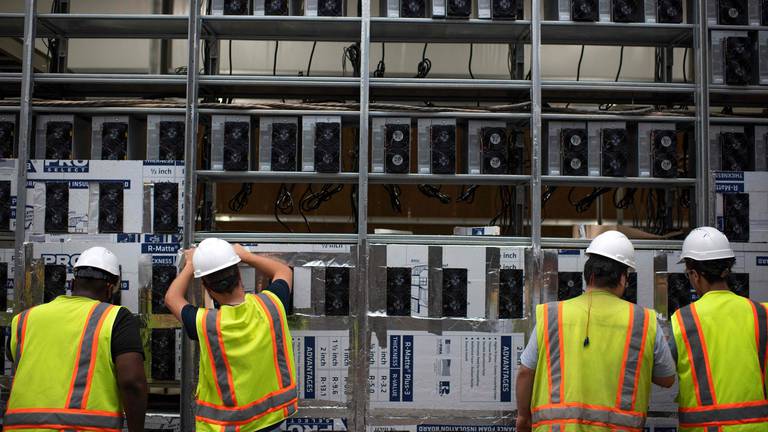
It is estimated that the electricity used to mine Bitcoin each year is eight times greater than the combined use of technology companies Google and Facebook. This raises concerns about the potential environmental impacts of digital currency.
According to Data provider TradingPlatforms, the world’s largest cryptocurrency consumes 143 terawatt hours of power each year. This is more than many European countries with medium size. To put this in perspective, global data centers consume approximately 205TWh annually; Bitcoin consumes 70% of that figure.
Google, owned by Alphabet, is the world’s largest search engine. It uses 12TWh which is approximately a 12th of Bitcoins energy consumption. Meta Plaftorms Facebook, the largest social network in the world, uses only 5TWh to perform its functions, which is 3.5 percent of what Bitcoin requires.
Norway and Switzerland only need 124TWh (or 56TWh) respectively.
Edith Reads, a TradingPlatforms author, stated that statistics paint a grim picture of the Earth.
“The energy Bitcoin uses is alarming. Its transactions consume more energy than whole countries at the moment. This is due to the asset’s increasing mining difficulty, which requires more power to execute.
There has been a lot of attention paid to the environmental impacts of Bitcoin and the entire cryptocurrency market.
According to Money Supermarket’s study, Bitcoin is the most energy-hungry cryptocurrency. A single transaction requires an average of 1,173 Kilowatt-hours. It was found that the average UK household’s electricity consumption is 350kWh per month, which is sufficient to power a typical UK home for three months.
This would be equivalent to approximately six weeks of electricity, based on an average US household electricity use of 877kWh per year.
Ethereum, the second-largest cryptocurrency in the world, requires only 87.29kWh per transaction, which is just 7.4% of what Bitcoin needs. Money Supermarket stated that Bitcoin Cash and Litecoin require only 19kWh each, while the rest of us don’t even need 1kWh.
Cambridge University researchers discovered that Bitcoin’s annual energy consumption was higher than that of the UAE. They logged in 120 TWh per annum, compared to the UAE’s 119.45TWh.
Bloomberg also reported in the same month that the Nordic region was losing its edge for green Bitcoin mining. This comes at a time when investors’ appetite for cryptocurrency has grown and the industry is being scrutinized more closely for carbon emissions.
The cryptocurrency fell below $30,000 for first time since January, when China, the largest power consumer in the world, shut down Bitcoin mining operations in Sichuan in June to address environmental concerns.
Ms. Reads stated that Bitcoin’s bad reputation is mainly due to its technology. It uses a proof-of-work consensus mechanism for validating transactions. This requires a lot of energy and hardware, and releases a lot of waste into our environment.
“Additionally, a large portion of the country’s mining activity is dependent on non-renewable energies. These resources are cheap and attractive for many miners. She said that coal and other fossil fuels have a large carbon footprint.
According to Brussels-based EnerGuide, the power consumption of a computer depends on its type. The average desktop consumes 200 watts per hour when it is in use, including speakers and printers. It consumes almost 600KWh per year and emits 175 kg of carbon dioxide if it is left on for more than eight hours per day.
Laptops, however, use between 50 and 100 watts per hour when they are turned on. It consumes between 150kWh to 300kWh per day and emits between 44kg to 88kg of CO2 annually if it is turned on for 8 hours. Standby mode reduces the power consumption of both a laptop and a desktop by around a third.
Non-fungible tokens, which are cryptocurrency assets that use Blockchain to track the ownership status digital objects, add to cryptocurrencies’ carbon footprint. Every step in the NFT cycle is dependent on energy. Money Supermarket estimates that an average NFT consumes 340kWh and has 241kg of carbon footprint.
The latest cryptocurrency market craze still consumes significantly less energy than its counterparts, but it still uses more electricity at 0.3TWh than 28 countries. It is just behind Antigua & Barbuda.
The Bitcoin community has not been silent about the criticism, its supporters pointing out that digital assets leave a larger footprint than other mundane activities, as Ms Reads stated.
Despite pressure from regulators and environmentalists, some of the largest banks in the world – which includes JPMorgan Chase and Bank of America , Morgan Stanley , Morgan Stanley, Citigroup and Goldman Sachs – have committed to reducing their carbon footprint.
The cryptocurrency industry is also striving to be cleaner and more environmentally friendly. Part of this shift involves the adoption renewable energy for validating transactions. These include solar, wind, and geothermal power.
According to a report by the Global Carbon Project, the world will emit 36.4 gigatonnes carbon dioxide in 2021. This is close to 2019 levels. At the recent Cop26 summit, world leaders worked together to tackle the problem.
According to CoinMarketCap data, Bitcoin’s price was $46,412.75 as of Thursday morning. This is almost 3% less than the previous 24 hours. The market capitalization of the entire cryptocurrency sector was more than $2.17 trillion.
